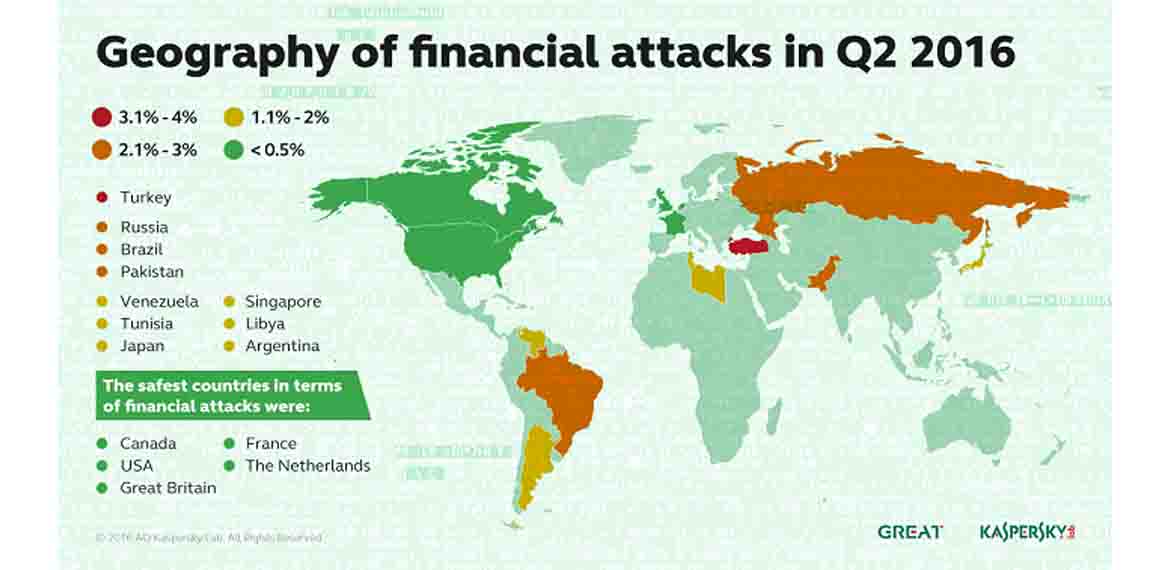Nearly 2-in-10 Computers in PH Infected in Q2 2016
The report based on Kaspersky Security Network (KSN) also revealed Kaspersky Lab products detected 23,719 Internet-borne malware incidents on the computers of Philippine-based KSN participants during the second quarter of 2016.
This means 14.78 percent or nearly two in 10 desktops in the country have encountered malware threats from April until June this year. This ranked the Philippines in the 44th spot among 213 countries with the greatest proportion of computers where malicious objects have been discovered.
Aside from the internet-based malware, the country has also remained one of the prime targets of mobile malware. It can be recalled that the Philippines placed 7th in nation’s most-attacked of this type of threat during the first quarter of 2016.
The country is not among the top 10 nations in terms of mobile malware infection for Q2 2016. But the Philippines is still well-within the “high-risk” group which recorded 15 to 37 percent number of users attacked. This means at least two-in-10 Filipino mobile users remain highly vulnerable to this type of threat.
“Mobile malware infections in the Philippines for 2016’s second quarter were not as high as the recorded incidents during the first three months of the year, but it is still among the most vulnerable countries. Filipinos should still be vigilant against mobile threats. Eager hackers are stealthily doing everything to steal the privacy, the identity and the money of more than 40 million smartphone users in the Philippines. No one is exempted, everyone is vulnerable,” warns Anthony Chua, Territory Channel Manager for the Philippines and Singapore at Kaspersky Lab Southeast Asia.
Meanwhile, the top 10 countries in terms of users infected with mobile malware in Q2 2016 include China (36.31%), Bangladesh (32.66%), Nepal (30.61%), Uzbekiztan (22.43%), Algeria (22.16%), Nigeria (21.84%), India (21.64), Indonesia (21.35 %), Pakistan (19.49%) and Iran (19.19%). All countries in the top ten list except China are attacked mostly by mobile Adware.
The safest countries were Austria (3.6%), Sweden (2.9%) and Japan (1.7%).
Other online threat statistics from the Q2, 2016 report include:
● In total, in Q2 Kaspersky Lab products blocked 171,895, 830 online attacks against users.
● Malware originated in 191 countries, although an overwhelming 81% came from just ten countries, led by the USA, (35.4%) Russia (10.3%) and Germany (8.9%).
● 54,539,948 unique URLs were recognized as malicious by the company’s security solutions, a 17% decrease on the same quarter in 2015.
● Every fifth PC user faced web-attack at least during the quarter.
● Kaspersky Lab products detected 16,119,489 unique malicious objects: scripts, exploits, executable files, etc.
● The safest countries for online activity were Canada (15%), Romania (14.6%) and Belgium (13.7%), while the countries at highest risk of Internet infection were Azerbaijan (32.1%), Russia (30.8%) and China (29.4%).
To mitigate the risk of infection, users are advised to:
● Use robust security solutions and make sure they keep your software up to date.
● Regularly run a system scan to check for possible infection.
● Stay wise while online. Do not enter personal information into a website if you are at all unsure or suspicious.
Statistics
Kaspersky Security Network is a distributed antivirus network that works with various anti-malware protection components. The data was collected from KSN users who agreed to provide it. Millions of Kaspersky Lab product users from 213 countries and territories worldwide participate in this global exchange of information about malicious activity.
Read the full version of the Kaspersky Lab’s IT threat evolution in Q2 Report at Securelist.com.











